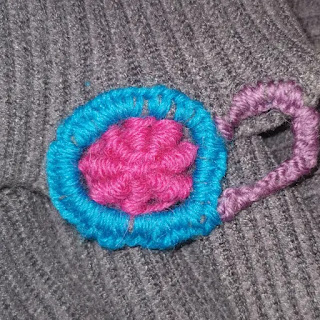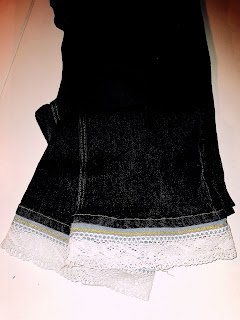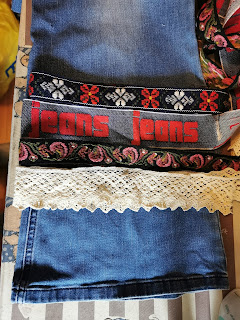I find it interesting to see how different people create holes in their clothes. Most of us keep getting holes in the same place.
Probably because of how we wear our clothe and what we wear. Some holes lare related to our work or our habits.
I don’t know if you ever thought about it?
As I was researching for this post I came to realise we had very few sleeves with holes, especially since Mr Mayhem isn’t driving so much., You know, he would lean on his elbows while he was driving.
I more often get a hole at the heel of my socks, but Mr Mayhem seems to get holes at the toe. This is what I mean about how different people create holes in their clothes.
And at the moment we don’t seem to have any sleeves to repair.
So to show you examples and tutorials for mending sleeves, I had to ask people on Facebook for sleeves in need of repair. After this request,everyone here found lots of sleeves to repair at home too. Now I’ll probably be repairing sleeves for a long time.
Often the sleeve or the cuffs on your sweater or shirt is the first place you’ll notice most wear and tear.
The cuffs often get holes at the edge. Often the rest of the sweater, jumper, shirt, blouse or cardigan will be fine.
So how do you fix the edges of cuffs?
There are several ways you can approach this mend, depending on your garment and what it’s made of.
A keen sewer would probably replace a rib knit cuff with a new one, but as a mender you might think about this a lot differently.
I have replaced a lot of cuffs on sweaters and sweatpants before. But not everyone has rib knit fabric at home. As a mender, you probably think of repairing a cuff before replacing it.
So what can you do? Here are some examples you can consider.
Darn it
Patch it up with a piece of fabric.
I think we have covered darning pretty well in earlier blog posts before. But there are several darning techniques you can choose.
Duplicate stitch
Blanket stitch
Darning using crochet
Darning by weaving
Use festive colours to make it fun and visible or use colour similar to the fabric to make it more invisible.
A good tip is to insert a bottle inside the sleeve, using it as a darning mushroom.
You can also use a small embroidery frame to set up your mending.
If you have a knitted sweater or jacket, you can knit a new cuff by picking up the stitches under the damage and unpick the broken bit and knit a new one. Simple
For rib knits you can often see it’s splitting at first. You might get away with using blanket stitch just around the edge. It’s even possible to add a missing piece by just blanket stitch back and forth so the edge looks smooth depending on where the fabric needs to be mended.
You can also use Zigzag stitches with your sewing machine to mend the cuff.
There are so many ways to use blanket stitch. You can see different solutions in the blog
https://themendingmayhem.blogspot.com/2021/07/blanket-stitch.html
I like to create new crochet lace onto the blanket stitch edge. Mr Mayhem isn’t that keen on having lace on his cuffs or sleeves though, and definitely not a style for the teenager either.
If it’s more worn you might try to cover it with some similar fabric. Like from an old t-shirt. Remember rib knits are elastic and you need to get your arm into it after you are done so knit fabrics are a very good solution to mend these cuffs.
You might prefer to use fold over elastic or maybe elastic lace.
Of course it also depends if the worn bits goes all the way around or it’s just a little bit worn out in one spot.
If it’s just a little bit you might get away with a patch out of sturdy fabric.
Also the top of a sock will work well as a replacement for a broken rib knit.
As an example wool underwear is expensive and is much more expensive than to replace a sock. Often the top of the sock will be fine even if the heel or toe has holes.
Small embroidery motifs are great ways to cover holes. Try using these to embellish your garments. You can even keep the hole by embroidery around it. It actually looks really cool.
Small doilies can work to mend clothes.
Adding buttons or beads works fine for smaller holes and to cover stains on fabrics
For cuffs in sturdy fabric like shirts you don’t have to think about this because these are easier to patch or darn.
Several small patches in different colours creates a fabulous look.
Choose hand stitching or use a sewing machine.
I like the texture with hand stitching. But I’m some times lazy and have other chores to do so I use the sewing machine instead.
If it’s only the edges you can cover it with a strip of fabric or a bias binding.
Embroidery, beads, buttons, darning, lace or doilies works fine with sturdy fabric as well.
For sturdy fabric patches I use adhesive to keep the patch from fraying if it’s not folded in.
I also use adhesive for kitted fabric patches. [not the rib knit] and an adhesive with glue on both sides if it’s to mend knit fabric.
I often like to stitch around the patch even if I use adhesive so the edges do not fray
And I think it looks better.
I think elbow patches are a very good alternative if it’s a large hole at the elbow. This is a classic style technique you’ll see in high fashion jackets and pullovers. Using elbow patches is decorative and rather easy to manage if you aren’t very experienced in mending. And darning a huge hole can be tricky so an elbow patch is a good mending solution.
If it’s a knitted item you first need to make sure that you have secured all stitches so the stitches will stop unravelling more.
I prefer to use a strong, sturdy fabric for elbow patches like denim, corduroy etc. Leather works fine too but be aware that leather is harder to work with. Suede leather is a bit easier. You can also find suede leather patches with holes around the edge so these are easy to sew them on.
It’s also possible to buy iron- on patches for elbows.
I prefer to make my own as I have huge stash of donated jeans and other fabric. Then I can make them the exact size I need or want to use.
I often use adhesive if it’s not folded in. It’s smart to cut notches into the edges of the fabric if you are folding it in especially with oval or round patches. So much easier to fold in nicely.
Make sure your patches are positioned in the same place for both sleeves.
For a knitted items knitted elbow patch or use crochet motifs. Both work fine on clothes that aren’t knitted as well.
I found a free pattern for knitted elbow patches here https://www.purlsoho.com/create/2014/01/09/lauras-loop-knit-elbow-patches/
It’s also possible to just use a piece of fabric to patch your elbow hole. If you go for elbow patches you need to do both in my opinion. But you can get away with a smaller patch on one sleeve.
And there is nothing to say you need to make an ordinary shaped patch. Why not make a star or a heart or anything else you can imagine. It just needs to be big enough to cover your hole
You can also make any kind of embroidery on your patch to make it special. Or find a ready made embroidery from a table cloth or another garment.
I think good stitches to use for adding elbow patches include
Blanket stitch
Whip stitch
Back stitch
If you know you get elbow holes. You might want to add elbow patches before you actually get a hole.
You'll find reels over at
Instagram Demonstrating the different techniques
Thanks for reading
Katrine
























































